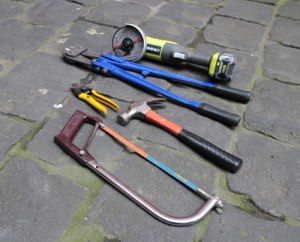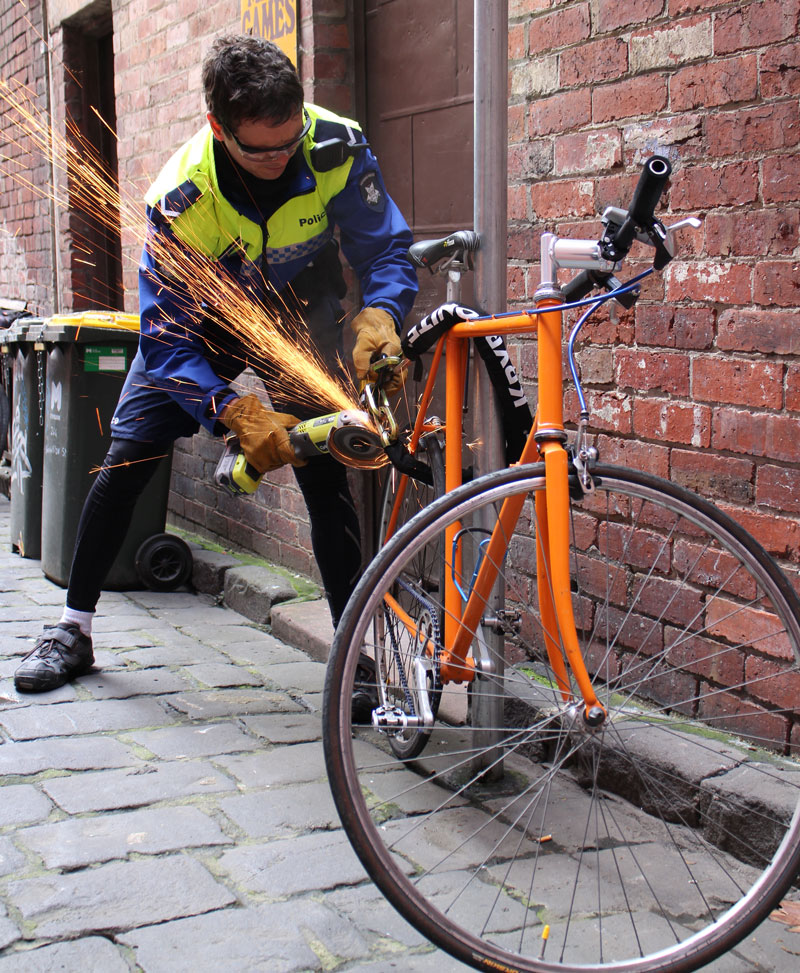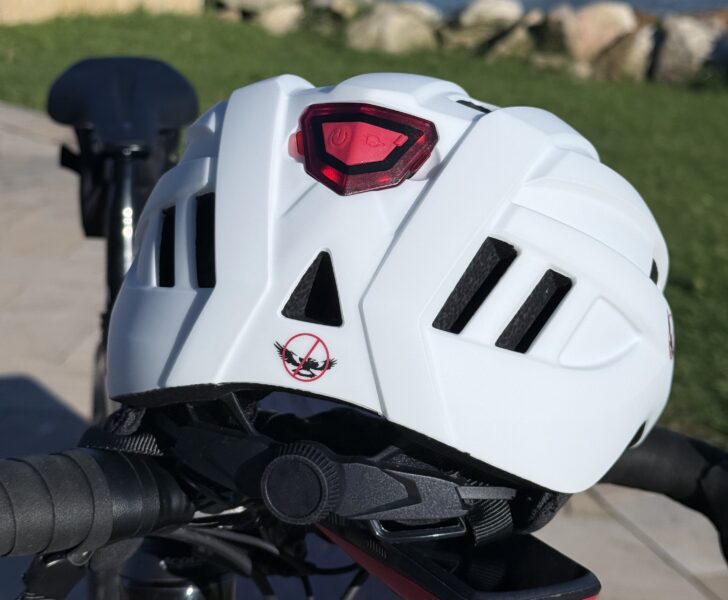Locks test 2013
The 2013 test’s expanded assessment includes a Ride On security rating. Which is the only lock to score a perfect 10? What level of security do you need? SimonVincett reveals all the test results.

Do you think you can tell a tough bike lock at a glance? Well, nothing is certain until the tools come out, and that’s what we rely on here at Ride On for our annual bike lock showdown. It’s not all brute force and flying sparks though, before the locks’ toughness is tested we see how well they work in the real world. After all, it’s not worth having the toughest lock if it’s annoying to use.

The new top lock for this year is a model we’ve been looking forward to testing. The brilliantly named New York Fahgettaboudit d-lock—and it didn’t disappoint. The mighty 18mm shackle stood up to all the cutting and smashing tools including the angle grinder. After more than two minutes of cutting it (with a metal cutting blade), we still hadn’t broken through. We had to cut a second time to release the bike. It’s weighty, at just under two kilograms, but it’s the only lock to score a perfect 10 security rating.
On the usability front, two locks stood out—the titanium bow lock, the TiGr, and the wearable Hiplok. The TiGr is designed to capture two wheels and the frame of your bike. It’s also very flexible to bend out around a solid anchor. To carry the lock, you slide it along the top tube of your bike frame and hold it in place with the velcro straps provided. The Hiplok is a chain designed to be worn around the hips. It’s comfortable and extremely convenient to use, though the Lite version isn’t as secure as the beefier, original model. Finally, when your situation really calls for a flexible lock, we’re pleased to be able to recommend some top performing cables and chains.
We recognise that some locks are not meant to be used in high-risk situations, so we assess as high, medium or low security. This allows us to acknowledge that a light, easy-to-use, low-security lock is an appropriate choice for a low-risk situation. Such a lock can achieve a high rating within its category. From the 26 locks rated in the table over the page you should find a model that suits you. The nine locks featured opposite are top performers that offer a variety of formats and features in a range of prices. At least one of the brands should be available from a shop near you.
Security assessment
We use tools that can be stashed in a sports bag carried by a person on foot. Therefore, the bolt cutters are 63cm in length and the angle grinder is battery powered, for instance.

The locks are first attacked with a hammer, which the 2011 test showed is sometimes successful. Next we try boltcutters and cable cutters, and then a hacksaw. With these hand tools the testers are invited to use multiple tools in tandem. Finally, we use a battery-powered angle grinder. The attacks are timed and abandoned after three minutes or earlier if continuation is futile.
Other routine assessment
Each lock is assessed according to the four categories Ride On uses to review any product: function, quality, price and appearance. Scores in all these areas are weighted for significance and combined to produce an overall rating, expressed as a percentage.
‘Function’ in this test also encompasses assessment of the weight, usability, options for carrying the lock and other considerations such as whether the lock will damage the user’s bike when in use. ‘Quality’ and ‘price’ are assessed relative to other products on the market, informed by how the lock performed in the security testing. ‘Appearance’ is a subjective, but necessary, assessment. As with all Ride On ratings, ‘price’ and ‘appearance’ have a lesser weighting, being just 10% of the overall rating each.
attack times are affected by the practical difficulty of getting at each lock
The security score is then combined with the ‘function’ score from the other assessment to become the overall ‘function’ score. It must be weighted, however, to reflect that security is the most important function of a lock. Therefore, we make security 60% of the total ‘function’ score, with other ‘function’ aspects making up the remaining 40%. The ‘quality’, ‘price’ and ‘appearance’ scores come from the other routine assessment to be combined for the overall rating.
We revised our rating system in 2013 and results from the previous two locks tests have been put through this year’s rating system to keep the comparison of all the locks consistent. This explains some variations in scores from last year. We also had a larger sample this year—due to new locks added to the previous ones. This allowed more comparison between models with similar characteristics. The effect is that some models previously tested were shown up as not as impressive next to newly tested models.
It’s important to note that the attack times are affected by the practical difficulty of getting at each lock. We attach the locks to a bike and a street pole before attacking them, so it’s a realistic situation. Leverage and hammer attacks have to be done without damaging the bike and smaller d-locks are usually harder to cut without nicking the bike too. Similarly, it’s often hard to keep chains steady while attacking them. Therefore, attack times can be higher than you might expect based simply on the materials from which the locks are made.

The nine best locks in their categories are featured below and the top 26 are listed in the final table.
High security
This category resist attack by hammer, boltcutters and hacksaw and could only be cut by an angle grinder.
Kryptonite New York Fahgettaboudit
$110 1985g
- 18mm shackle took 130 seconds to cut once
- Two cuts required to release
93%
Heavy but ultimate security for a good price
For retailers call Cassons (02) 8892 1900
$199 1397g
- 13mm shackle took 73 seconds to cut once
- Two cuts required to release
90%
Pricy but awesome security for the weight
For dealers www.velovita.com.au
Vulcan Supreme 2000
$40 954g
- Shackle took 42 seconds to cut once
- Two cuts required to release
87%
Highly secure, bargain price
For dealers www.bicorp.com.au
- Tricky to hold steady; 23 seconds to cut once
- Two cuts required to release
86%
The best chain option
For dealers www.knog.com.au
Medium security
These three are the best medium security locks we’ve tested. They foiled the hand tools but quickly succumbed to the angle grinder.
$90 1080g
- Braided cable covered with thick silicone encased in tough nylon sleeve
87%
Not cheap, but the toughest cable around
For dealers www.velovita.com.au
$50 468g
- Thick silicone covering is a real nuisance for hand tools
85%
More than a pretty face
For dealers www.knog.com.au
$35 642g
- Thick casing and braided cable defeated bolt cutters
82%
Average looks with surprising performance
For dealers www.velovita.com.au
Low security
The top two low security locks offer light weight and convenience but a low level of deterrence.
$35 425g
- Bottle cage mount makes very convenient operation
75%
Convenient and long cable
For dealers www.blueglobe.com.au
$25 321g
- Colourful, light and cheap
65%
Funky option for low-risk lock ups
For dealers www.knog.com.au
Ride On content is editorially independent, but is supported financially by members of Bicycle Network. If you enjoy our articles and want to support the future publication of high-quality content, please consider helping out by becoming a member.


















Always nice to have something like this to assist in making an educated purchase to protect your vehicle.
It is a shame though that not all the data on the top end locks was made available, as I really would like to see how the rest of the high security locks faired in comparison. Is there a data sheet that shows cut times for all? I am specifically interested to see how the hiplok held up, and the time it took to open. Thanks – Evan
TiGr is incorrect, it has been demonstrated as defeated in 5 seconds with boltcutters, does _not_ need an angle grinder. Source:
http://www.bikehugger.com/post/view/tigr-lock-break-and-update
(Yes, I am aware that it’s a bigger boltcutter than used in this test, but still.)
Demonstrated defeated with hacksaw and vicegrips @2:55
http://www.bicycling.com/video/unlocked-video#/video/all/created/d/1
Defeated in 76 seconds with handsaw:
http://www.mensjournal.com/expert-advice/torture-test-bike-locks-20120925/tigr-lock
Also, as a high-tensile matrial , it may be vulnerable to freeze-smash attacks (as per car steering wheel locks)
Thanks for the interest in our product – we always appreciate feedback.
In this case we would like to clarify that the 0.75” wide version of the TiGr Lock bow in the German Stiftung Warentest video referenced above via the Bike Hugger link is different from the 1.25” wide version of the TiGr lock listed in rideOn’s excellent product review.
Unfortunately Stiftung Warentest incorrectly identifies the lock they show in their article/video as our highest security lock, when in fact they only show/mention the lighter weight/lower security variation of the TiGr Lock bow.
We understand the confusion (or even shock) by those who have seen the Stiftung Warentest piece since Stiftung Warentest chose not to mention the part about the different variations of the TiGr Lock.
We described the differences between the 0.75” and 1.25” widths in the description of the TiGr Lock in our Kickstarter campaign and have continued to do so since the products launched; the 0.75” wide versions of the locks don’t offer as much security as the 1.25” wide versions of the lock because there is 67% more Ti to break in the wider version. The Stiftung Warentest article only shows/mentions the 0.75” wide version of the TiGr Lock. The RideOn report only shows/mentions the 1.25” wide version of the TiGr Lock. Comparing the lock in the Stiftung Warentest article to the lock in the rideOn product review is a bit like comparing apples to oranges.
Bike security is a balance of usability, security, aesthetic, cost & weight. At TiGr, we believe we have struck a balance between these important variables in a revolutionary new type of lock. The 1.25” wide variation of the TiGr lock provides a high level of security, while being one of the lightest – if not the lightest – ART certified locks in the U-lock, Chain or Folding lock categories. The 0.75” wide version of the TiGr Lock is even lighter, more flexible, but more vulnerable to some types of attack.
Here’s the link to the Kickstarter project page: https://www.kickstarter.com/projects/1051734209/tigr-titanium-lock-as-cool-as-your-bike
Here’s the link to the list of ART certified locks: http://www.stichtingart.nl/sloten_resultaat.asp
For those who may be interested, here is another useful review of bike locks in which two self-described bike thieves (one opportunistic and one more determined) describe their approach to breaking locks: http://thesweethome.com/reviews/best-bike-lock/. Neither of those thieves was able to break the TiGr Lock (1.25” version) with the tools they brought to the test for that article.
We appreciate the interest in our products and passion for bike security shown in the comment. We share that passion. As bicyclists who know all too well the pain of losing bikes to thieves. It is that passion, and our love of riding bikes, that drives us to make locks that are both hard to break and easy to use.
Happy Riding,
The Team at TiGr Lock
You also need to test them by flipping the bike over (while it’s locked to a bike hoop) to see if it breaks the D-lock. In some cases this will break the D-lock, or it might break the bike frame, and it’s a common method used by thieves – no tools required. I found this out via some seasoned juvenile delinquents…
In your lock studies, did you happen to find any cable locks that were “Key Retaining”? I have been searching for a key retaining cable lock for months. The lock that I was using was a Saicoss lock but, I cannot find any information on this lock company. Any suggestions?